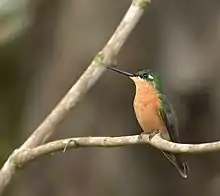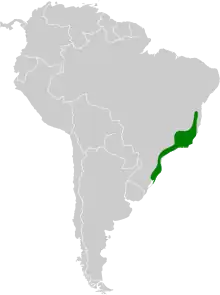Brazilian ruby
The Brazilian ruby (Heliodoxa rubricauda) is a species of hummingbird in the "brilliants", tribe Heliantheini in subfamily Lesbiinae. It is endemic to Brazil.[3][4]
| Brazilian ruby | |
|---|---|
 | |
| female | |
 | |
| male | |
| Scientific classification | |
| Domain: | Eukaryota |
| Kingdom: | Animalia |
| Phylum: | Chordata |
| Clade: | Dinosauria |
| Class: | Aves |
| Clade: | Strisores |
| Order: | Apodiformes |
| Family: | Trochilidae |
| Tribe: | Heliantheini |
| Genus: | Heliodoxa |
| Species: | H. rubricauda |
| Binomial name | |
| Heliodoxa rubricauda (Boddaert, 1783) | |
 | |
| Synonyms | |
|
Clytolaema rubricauda (Gould, 1853) | |
Taxonomy and systematics
The Brazilian ruby was described by the French polymath Georges-Louis Leclerc, Comte de Buffon in 1780 in his Histoire Naturelle des Oiseaux.[5] The bird was also illustrated in a hand-colored plate engraved by François-Nicolas Martinet in the Planches Enluminées D'Histoire Naturelle which was produced under the supervision of Edme-Louis Daubenton to accompany Buffon's text.[6] Neither the plate caption nor Buffon's description included a scientific name but in 1783 the Dutch naturalist Pieter Boddaert coined the binomial name Trochilus rubicauda in his catalogue of the Planches Enluminées.[7] The type locality is Rio de Janeiro in Brazil.[8]
The Brazilian ruby was at one time the only species in the genus Clytolaema that was introduced by the ornithologist and bird artist John Gould in 1853.[9] However, a 2014 publication provided evidence that Clytolaema is embedded within genus Heliodoxa. The South American Classification Committee of the American Ornithological Society (SACC) and the International Ornithological Committee (IOC) adopted the change in mid-2022.[10][3] As of that date the Clements taxonomy and BirdLife International's Handbook of the Birds of the World retained it in Clytolaema.[11][12]
The Brazilian ruby's earlier generic name Clytolaema combined the Ancient Greek klutos meaning "glorious" and laimos meaning "throat". The specific epithet rubricauda combines the Latin ruber meaning "red" and cauda meaning "tail".[13]
Description
The Brazilian ruby is 10.8 to 11.3 cm (4.3 to 4.4 in) long. Males weigh 7 to 9.2 g (0.25 to 0.32 oz) and females 5.9 to 7.1 g (0.21 to 0.25 oz). Both sexes have a medium length black bill and a white spot behind the eye. Adult males have an iridescent emerald green forehead and crown, a green nape, and a golden bronze back and rump. The chin is blackish, the gorget shining ruby red, the breast iridescent emerald green, and the belly dark gray with green speckles. The central tail feathers are golden bronze and the rest rufous with bronze edges. Adult females have a grass green crown and back and a cinnamon rump. Their underparts are entirely cinnamon. Their tail is like the male's. Juveniles are like females with the addition of buff fringes on the head feathers. Melanistic morph individuals are frequent.[14]
Distribution and habitat
The Brazilian ruby is found in eastern and southeastern Brazil from Bahia south to Rio Grande do Sul. It inhabits the interior of forest, scrublands, parks, and banana plantations, and is frequently seen at feeders. In elevation it is most numerous below 500 m (1,600 ft) but ranges as high as 1,500 m (4,900 ft).[14]
Behavior
Movement
The Brazilian ruby is mostly sedentary but locally makes some seasonal elevational movements.[14]
Feeding
The Brazilian ruby feeds on nectar from a wide variety of flowering plants and trees, both native and introduced. Males often defend feeding territories and females sometimes do. They also capture small insects by hawking from a perch.[14]
Breeding
The Brazilian ruby's breeding season spans from November to March. It makes a cup nest of soft plant material with lichen on the outside and places it on a horizontal branch, typically 3 to 10 m (10 to 30 ft) above the ground. The female incubates the clutch of two eggs for 15 to 16 days; fledging occurs about 25 days after hatch.[14]
Vocalization
The Brazilian ruby's song is described as "jig chrrrrrr....jig cherrrrrr...jig chrrrrrr". It also makes a "jig jig jig" call.[14]
Status
The IUCN has assessed the Brazilian ruby as being of Least Concern. Though it has a large range, its population size and trend are unknown. No immediate threats have been identified.[1] It occurs in several protected areas, and is "[c]ommon throughout [its] range...and readily accepts man-made habitats like tree-filled gardens, parks and plantations."[14]
References
- BirdLife International (2016). "Brazilian Ruby Clytolaema rubricauda". IUCN Red List of Threatened Species. 2016: e.T22687712A93165369. doi:10.2305/IUCN.UK.2016-3.RLTS.T22687712A93165369.en. Retrieved 10 May 2022.
- "Appendices | CITES". cites.org. Retrieved 2022-01-14.
- Gill, F.; Donsker, D.; Rasmussen, P., eds. (August 2022). "Hummingbirds". IOC World Bird List. v 12.2. Retrieved August 8, 2022.
- HBW and BirdLife International (2020) Handbook of the Birds of the World and BirdLife International digital checklist of the birds of the world Version 5. Available at: http://datazone.birdlife.org/userfiles/file/Species/Taxonomy/HBW-BirdLife_Checklist_v5_Dec20.zip [.xls zipped 1 MB] retrieved 27 May 2021
- Buffon, Georges-Louis Leclerc de (1780). "Le rubis émeraude". Histoire Naturelle des Oiseaux (in French). Vol. 11. Paris: De L'Imprimerie Royale. p. 43.
- Buffon, Georges-Louis Leclerc de; Martinet, François-Nicolas; Daubenton, Edme-Louis; Daubenton, Louis-Jean-Marie (1765–1783). "Oiseau-mouche à gorge rouge, de Bresil". Planches Enluminées D'Histoire Naturelle. Vol. 3. Paris: De L'Imprimerie Royale. Plate 276 Fig. 4.
- Boddaert, Pieter (1783). Table des planches enluminéez d'histoire naturelle de M. D'Aubenton : avec les denominations de M.M. de Buffon, Brisson, Edwards, Linnaeus et Latham, precedé d'une notice des principaux ouvrages zoologiques enluminés (in French). Utrecht. p. 17, Number 276 Fig. 4.
- Peters, James Lee, ed. (1945). Check-list of Birds of the World. Vol. 5. Cambridge, Massachusetts: Harvard University Press. p. 86.
- Gould, John (1853). A Monograph of the Trochilidae, or Family of Humming-Birds. Vol. 4. London: self. Plate 249 and text (Part 6 Plate 2). The 5 volumes were issued in 25 parts between 1849 and 1861. Title pages of all volumes bear the date of 1861.
- Remsen, J. V., Jr., J. I. Areta, E. Bonaccorso, S. Claramunt, A. Jaramillo, D. F. Lane, J. F. Pacheco, M. B. Robbins, F. G. Stiles, and K. J. Zimmer. Version 24 July 2022. A classification of the bird species of South America. American Ornithological Society. https://www.museum.lsu.edu/~Remsen/SACCBaseline.htm retrieved July 24, 2022
- Clements, J. F., T. S. Schulenberg, M. J. Iliff, S. M. Billerman, T. A. Fredericks, J. A. Gerbracht, D. Lepage, B. L. Sullivan, and C. L. Wood. 2021. The eBird/Clements checklist of Birds of the World: v2021. Downloaded from https://www.birds.cornell.edu/clementschecklist/download/ Retrieved August 25, 2021
- HBW and BirdLife International (2021) Handbook of the Birds of the World and BirdLife International digital checklist of the birds of the world. Version 6. Available at: http://datazone.birdlife.org/userfiles/file/Species/Taxonomy/HBW-BirdLife_Checklist_v6_Dec21.zip retrieved August 7, 2022
- Jobling, James A. (2010). The Helm Dictionary of Scientific Bird Names. London: Christopher Helm. pp. 111, 340. ISBN 978-1-4081-2501-4.
- Schuchmann, K.L. and G. M. Kirwan (2020). Brazilian Ruby (Clytolaema rubricauda), version 1.0. In Birds of the World (J. del Hoyo, A. Elliott, J. Sargatal, D. A. Christie, and E. de Juana, Editors). Cornell Lab of Ornithology, Ithaca, NY, USA. https://doi.org/10.2173/bow.brarub1.01 retrieved 10 May 2022
